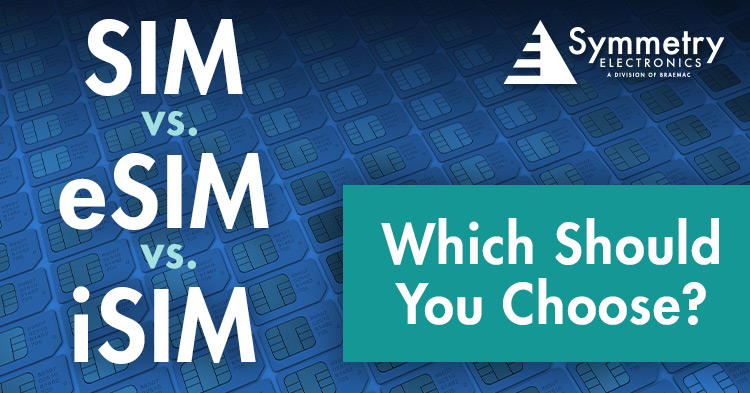- Home
- Symmetry Blog
- SIM vs. eSIM vs. iSIM | Which Should You Choose?
SIM vs. eSIM vs. iSIM
Which Should You Choose?
About Symmetry Electronics
Established in 1998, Symmetry Electronics, a Division of Braemac, is a global distributor of electronic components and systems. Combining premier components and comprehensive value-added services with an expert in-house engineering team, Symmetry supports engineers in the design, development, and deployment of a broad range of connected technologies.
Exponential Technology Group Member
Acquired by Berkshire Hathaway company TTI, Inc. in 2017, Symmetry Electronics is a proud Exponential Technology Group (XTG) member. A collection of specialty semiconductor distributors and engineering design firms, XTG stands alongside industry leaders TTI Inc., Mouser Electronics, and Sager Electronics. Together, we provide a united global supply chain solution with the shared mission of simplifying engineering, offering affordable technologies, and assisting engineers in accelerating time to market. For more information about XTG, visit www.xponentialgroup.com.

Developed in 1991, removable Subscriber Identification Modules (SIMs) are most commonly used in mobile phones for secure device identification and data storage. SIMs are now being used in both small and large Internet of Things (IoT) deployments as a link between a cellular device and a network.
Demand for SIMs continues to grow as IoT devices become more sophisticated, smaller, and advanced. In fact, Allied Market Research valued the market demand for SIM solutions to reach a significant $8.3 billion by 2032.

To compensate for increased demand, the Embedded Universal Integrated Circuit (eSIM) and Integrated SIM (iSIM) have become increasingly popular SIM solutions. Even with new SIM card options, removable SIM cards are still optimal components in several scenarios.
Why Do Developers Need Comprehensive Subscriber Identification Modules?
Selecting the right SIM solution is crucial for achieving optimal performance, reliability, security, and cost efficiency in IoT deployments. It requires careful consideration of various factors, including compatibility, connectivity, scalability, security, cost, and regulatory compliance.
- Secure Device Identification: SIMs provide a secure method for identifying devices on cellular networks, ensuring authentication, and preventing unauthorized access.
- Data Storage: SIMs offer storage capabilities for essential device information, network settings, and user data, facilitating seamless connectivity and operation.
- Compatibility: Choosing the right SIM solution ensures compatibility with various devices, networks, and communication protocols, ensuring seamless integration and interoperability.
- Scalability: With the growth of IoT deployments, developers require SIM solutions that can scale efficiently to accommodate large numbers of connected devices while maintaining reliability and performance.
- Remote Management: Comprehensive SIM solutions, such as eSIMs, support remote management features like Over-the-Air (OTA) provisioning, enabling convenient updates and maintenance without physical access to devices.
- Cost Efficiency: By selecting the most suitable SIM solution for their application needs, developers can optimize costs associated with device deployment, management, and maintenance over the device's lifecycle.
- Security: SIM solutions offer robust security features to safeguard sensitive data, mitigate cybersecurity risks, and protect against unauthorized access and tampering.
- Regulatory Compliance: Compliance with regulatory standards and industry requirements is essential for IoT deployments, and choosing the right SIM solution ensures adherence to relevant regulations and certifications.
The Evolution of Subscriber Identification Modules
Most commonly used in consumer mobile applications, SIMs have evolved over the years to meet various needs. Traditional SIMs come in three form factors:
- Mini SIM (25mm x 15mm x 0.76mm)
- Micro SIM (15mm x 12mm x 0.76mm)
- Nano SIM (12.33mm x 8.8mm x 0.67mm)
While they offer simplicity and ease of use, their physical nature poses limitations that particularly impact IoT applications. Additionally, the risk of theft, tampering, and the need for physical maintenance make them less suitable for certain environments and large-scale deployments.
How the eSIM Redefines Connectivity
The eSIM, a soldered chip directly integrated into a device’s printed circuit board (PCB), offers a significant size reduction compared to their traditional counterparts. eSIMs are ideal for compact IoT deployments and harsh outdoor environments, such as the connected car industry.

However, remote provisioning, while convenient, can be costly and challenging in areas with poor network coverage, Moreover, the inability to physically transfer eSIMs between devices may limit flexibility in certain scenarios.
eSIM Features
- Compact Size: eSIM chips are significantly smaller than traditional SIM cards, offering a space-saving solution for compact devices.
- Soldered Integration: eSIM chips are soldered directly onto a device's printed circuit board (PCB), providing a secure and permanent connection.
- Harsh Environment Compatibility: Designed for durability, eSIMs are suitable for use in harsh outdoor environments, such as automotive applications.
- Remote Provisioning: eSIMs support remote Over-the-Air (OTA) provisioning, allowing for convenient SIM profile updates without physical access to the device.
- Reduced Risk of Theft or Tampering: Since eSIMs are integrated into the device, there is a lower risk of theft or tampering compared to removable SIM cards.
- Security Features: eSIMs offer robust security features to protect sensitive data and ensure secure connectivity.
- Support for Large IoT Deployments: With the ability to provision SIM profiles remotely, eSIMs are well-suited for large-scale IoT deployments, facilitating efficient device management.
- Cost-Effectiveness: While initial implementation costs may vary, eSIMs can offer long-term cost savings through simplified device management and reduced physical maintenance requirements.
- Compatibility with Industry Standards: eSIM technology complies with industry standards, ensuring interoperability and compatibility with various devices and networks.
- Flexibility in Connectivity: eSIMs support multiple mobile network profiles, allowing devices to seamlessly switch between different networks based on availability and coverage, enhancing connectivity reliability.
What are iSIMs?
The iSIM is the next generation of SIM cards. Embedded directly within the system-on-chip (SoC) of devices like smartphones, smart wearables, and other connected devices, iSIMs combine a processor and cellular modem.

iSIM Features
- Embedded Integration: iSIM is embedded directly within the system-on-chip (SoC) of devices, eliminating the need for a separate physical SIM card. This integration streamlines device design and reduces hardware complexity.
- Space Efficiency: By combining the functionality of a SIM card, processor, and cellular modem into a single chip, iSIMs occupy minimal space on the device's printed circuit board (PCB), allowing for more compact designs and maximizing internal space for other components.
- Reduced Power Consumption: iSIMs typically consume less power compared to traditional SIM cards and external modem configurations. This results in improved battery life for devices, especially important for mobile and battery-powered IoT applications.
- Enhanced Security: With iSIMs being integrated directly into the SoC, they benefit from the security features inherent in the device's hardware architecture. This enhances the overall security of the device, protecting against various threats such as unauthorized access and data breaches.
- Remote Management Capabilities: iSIMs support remote management features, allowing for Over-the-Air (OTA) provisioning of SIM profiles and firmware updates. This enables efficient device management and maintenance without the need for physical access to the device.
- Design Flexibility: The integration of SIM functionality into the SoC provides device makers with greater flexibility in designing products. iSIMs enable more streamlined device architectures, reduce bill of materials (BOM) costs, and simplify manufacturing processes.
- Optimized Cost Structure: Integrating SIM functionality into the SoC can result in cost savings compared to traditional SIM card solutions. This is particularly beneficial for mass-market devices, such as entry-level smartphones and IoT devices, where cost optimization is critical for competitiveness.
- Wide Range of Applications: iSIMs are suitable for various applications across industries, including smartphones, wearables, IoT devices, automotive, and industrial applications. Their versatility and compact form factor make them ideal for integration into a wide range of connected devices.
- Compatibility with Industry Standards: iSIM technology complies with industry standards and specifications, ensuring interoperability with cellular networks and compatibility with existing infrastructure and protocols.
- Futureproofing: As technology evolves, iSIMs offer a future-proof solution for connected devices. Their integration into SoCs allows for seamless adoption of new cellular technologies and standards, ensuring compatibility and longevity of devices in the rapidly changing IoT landscape.
Determining Which SIM is Right for Your Application
While eSIMs and iSIMs offer their own embedded advantages, there are still some design scenarios where the benefits of traditional SIM chips might outweigh their modernized counterparts, including:
- Working within legacy systems
- Seeking interchangeability
- Required network compatibility
- Temporary or disposable devices
- Security concerns
- Regulatory requirements
- Cost considerations
Overall, when determining which SIM solution is best for your application, it is important to consider the following:
- What are my sizing limitations?
- What is the cost of my end product?
- Does the product require remote provisioning?
- Will the SIM card need to be removable?
- What is my budget?
- Is certification a major priority?
Stay ahead of the curve with Symmetry Electronics! Elevate your designs with the latest insights and updates. If you've found this information valuable, follow Symmetry Electronics on LinkedIn today!
